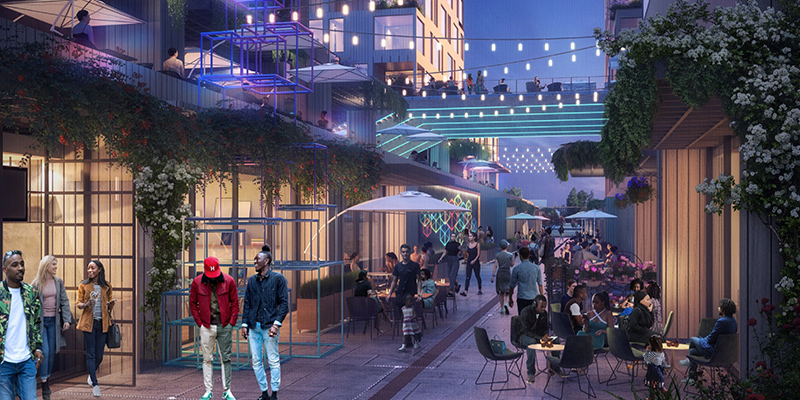When you travel to a different country, you expect to encounter a different landscape, culture and customs. But in many parts of the U.S., communities mere blocks or miles apart feel like wholly distinct worlds. Take Chicago: Its beautiful architecture and stunning lakeshore belie the staggering economic disparities among neighborhoods and real estate developments.
In Lincoln Park, a community on Chicago’s North Side, the median income is $123,044 and 85.6% of residents have a bachelor’s or graduate degree. Nearly 80% of Lincoln Park’s residents are white. Ten miles south, in the Woodlawn community, the median income is $28,794 and 26.1% of residents have a bachelor’s or higher degree. Eighty percent of Woodlawn’s residents are Black.
Drive through Lincoln Park and you’ll see high-end workout facilities, a range of shops and restaurants and an enormous Whole Foods. Drive through Woodlawn and you’ll spy far fewer amenities. Of these two communities, you can probably guess which has enjoyed large-scale, sustained investment and which has experienced underinvestment and systemic inequities.
Lincoln Park and Woodlawn residents share a city but inhabit vastly different realities. If real estate developers overlook or fail to adequately engage with a community’s unique needs and historical context, the effects can be deleterious. The most effective developments get to the heart of resolving economic disparities and transforming lives. These developers treat community members as true partners, not bystanders or obstacles. Even for developers with the best intentions, this is easier said than done.
What Are the Barriers to Meaningful Community Engagement?
When real estate developers not native to a neighborhood helm a development in that community, they often grapple with limited knowledge of the community’s nuances and an absence of trust from residents. Such challenges are exacerbated in communities of color when outside developers hail from a different racial or socioeconomic background.
Black and Hispanic real estate developers account for less than 1% of the industry. There are 112,000 real estate developers in our country; roughly 111,000 of them are white. This means Black and other communities of color rarely see themselves reflected among development teams — and the lived experience of developers diverges from that of residents, which can frustrate community engagement efforts.
Returning to the example of Chicago’s Woodlawn community, an outside developer may focus on the neighborhood’s deficits and prescribe “fixes,” rather than recognizing residents’ resilience, capitalizing on existing local assets and preserving the neighborhood’s cultural legacy. Outside developers mean well, but amid the complex processes that development requires (land acquisition, building permits, securing financing, navigating construction), it’s difficult to carve out the months or years needed for deep relationship building, even if communities are amenable.
Some developers might attempt to thread the needle by tapping an existing community resident to serve as their representative and promote their vision. This is risky and unlikely to succeed; residents know who’s behind the curtain and may feel the message is inauthentic at best, pandering at worse.
When community engagement falters or fails, an immediate risk is pushback from residents who’ve been sidelined. The long-term danger is displacement. This can happen gradually and inadvertently. Consider the effect of renderings and advertisements that aren’t inclusive and retail offerings that don’t represent the community, such as a chain coffee shop rather than a local small business. Over time, communities that were once vibrant and diverse become cookie-cutter and homogenous. Longtime residents are erased. Developers who are already embedded in a community avoid such dangers and unlock immense opportunities.
How Embedded Developers Drive Transformation
When longstanding community institutions, such as houses of worship, take on real estate development, the barriers to engagement fall away. New relationships with community stakeholders need not be built from the ground up — instead, existing relationships are harnessed.
Developers from within a community are highly attuned to residents’ wants and needs and to the area’s nuances, idiosyncrasies and historical and cultural context. Embedded developers have lived alongside residents, worshipping, celebrating, babysitting and breaking bread with the community. They can use insights from years of lived experience to partner with the community to design solutions to specific, complex problems. Such community-based developers aren’t new: More Black churches are transforming their underused land, such as vacant buildings and parking lots, into community-enhancing real estate developments.
The mark of a successful development, especially in an under-resourced or underinvested neighborhood, is one that promotes holistic prosperity and wellness. Worthwhile developments address social determinants of health such as safe housing; educational and job opportunities; quality health care; and access to nutritious food, physical activity and clean air and water. Such developments enrich, sustain and empower residents financially, intellectually, spiritually and culturally. In essence, a well-designed and conscientiously executed development can change a community’s trajectory, help close the racial wealth gap and make a lasting difference for future generations. Community engagement is integral to creating such robust, regenerative developments.
In Chicago, megadevelopment Woodlawn Central strives for such community-redefining change. Led by the Apostolic Church of God, a spiritual anchor in Woodlawn since 1932, the $895 million project will span 8 acres and include 870 new homes, retail, a hotel, office space, a vertical greenhouse, strengthened transit infrastructure and other amenities.
Because the Apostolic Church is part of the fabric of the neighborhood, community engagement is second nature — beginning even before the development was conceived. Years ago, the church helped create a community development organization called the Network of Woodlawn (NOW). Over the course of eight years, NOW drew from residents’ input to build the 2060 neighborhood plan, a vision for urban regeneration and sustainability. Woodlawn Central is the first phase of the 2060 plan.
Embedded community developers seldom have the same infrastructure and access to capital as outside developers. They often need added support, from financing pathways to reliable industry partners like architects and service providers. Still, embedded developers possess a rare advantage: an established, powerful rapport with the community that can revolutionize a neighborhood and reshape its future.
Featured image courtesy of Sherwood Design Engineers.
Content and strategies shared on NAIOP webinars and blog posts are intended to provide information and insights to industry practitioners and do not constitute advice or recommendations. NAIOP and its presenters disclaim any liability for actions taken as a result of these webinars and blog posts.













